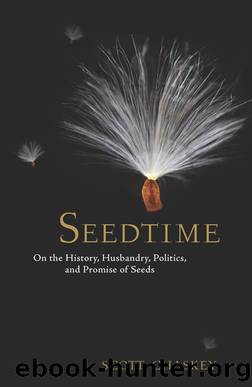Seedtime by Scott Chaskey

Author:Scott Chaskey
Language: eng
Format: epub
Publisher: Rodale
Published: 2014-08-14T16:00:00+00:00
Third World nations found their own genetic resources, albeit transformed by plant breeders, confronting them as commodities. This pattern has been seen as doubly inequitable because the commercial varieties purveyed by the seed trade have been developed out of germplasm initially obtained free from the Third World.
Developing countries reasoned that if the Northern countries insisted on claiming ownership of patented seeds, they could assert ownership of the genetic material collected in the South. To bolster the mission of an international seed bank, the Mexican delegation at the FAO proposed free access for both North and South to the seeds to be held within that depository—patented or not.
By 1984, the dispute had grown so bitter that the Wall Street Journal dubbed the controversy over the public/private ownership the “Seed Wars.” Cary Fowler claims that when he first appeared as a public advocate at the FAO meetings, he was labeled a “dangerous radical.” As a child of the sixties, inspired by poetry and “the perennial philosophy,” I am all too familiar with this moniker—and know well how perfectly sensible concepts that prove to have social and historical validity in the improvement of our human condition often appear to be dangerous or radical to the ruling order.
A few years later, in 1993, the FAO hired Fowler to oversee the drafting of a global plan of action; the end result would be a document—adopted by the United Nations in 2001—that contained the beginning legal framework for a world seed bank. The finished document was something of a compromise—farmers’ rights had survived, ensuring that farmers would receive some compensation for genetic material collected by the Northern seed trade, although the developing countries agreed not to press their opposition to seed patenting.
Norway had proposed building a world seed vault at Svalbard when the skirmishes of the seed wars were raging, but it wasn’t until the UN treaty was ratified that action was possible. A Nordic Gene Bank already existed there, in an abandoned coal mine, which served as a repository for seeds from five countries—Norway, Denmark, Finland, Iceland, and Sweden. Norway offered seed money and support in an effort to provide stability to the 1,700-plus gene banks scattered around the globe in more than 100 countries. Cary Fowler estimates that half of these seed banks—often created for short-term storage—exist in somewhat precarious conditions, due to inadequate funding, human conflict, or lack of government support.3 At Svalbard, a major portion of the estimated 7.4 million seed samples stored in a multitude of collections can eventually be conserved deep in a permafrost mountain.
The Norwegian Ministry of Agriculture and Food holds the legal and financial responsibility for the seed vault, and the day-to-day operation is jointly managed by the Norwegian Ministry, the Global Crop Diversity Trust, and the Nordic Genetic Resource Center. Designed to eventually store up to 4.5 million varieties—nearly two billion seeds—by February 2012, only 4 years after opening, the Svalbard bank housed 740,000 seed samples (among which can be found, for example, 40,000 varieties of beans and 140,000 varieties of wheat).
Download
This site does not store any files on its server. We only index and link to content provided by other sites. Please contact the content providers to delete copyright contents if any and email us, we'll remove relevant links or contents immediately.
| Automotive | Engineering |
| Transportation |
Whiskies Galore by Ian Buxton(41490)
Introduction to Aircraft Design (Cambridge Aerospace Series) by John P. Fielding(32857)
Small Unmanned Fixed-wing Aircraft Design by Andrew J. Keane Andras Sobester James P. Scanlan & András Sóbester & James P. Scanlan(32534)
Craft Beer for the Homebrewer by Michael Agnew(17902)
Turbulence by E. J. Noyes(7660)
The Complete Stick Figure Physics Tutorials by Allen Sarah(7097)
Kaplan MCAT General Chemistry Review by Kaplan(6548)
The Thirst by Nesbo Jo(6407)
Bad Blood by John Carreyrou(6245)
Modelling of Convective Heat and Mass Transfer in Rotating Flows by Igor V. Shevchuk(6207)
Learning SQL by Alan Beaulieu(5995)
Weapons of Math Destruction by Cathy O'Neil(5779)
Man-made Catastrophes and Risk Information Concealment by Dmitry Chernov & Didier Sornette(5593)
Digital Minimalism by Cal Newport;(5325)
Life 3.0: Being Human in the Age of Artificial Intelligence by Tegmark Max(5147)
iGen by Jean M. Twenge(5126)
Secrets of Antigravity Propulsion: Tesla, UFOs, and Classified Aerospace Technology by Ph.D. Paul A. Laviolette(4863)
Design of Trajectory Optimization Approach for Space Maneuver Vehicle Skip Entry Problems by Runqi Chai & Al Savvaris & Antonios Tsourdos & Senchun Chai(4807)
Electronic Devices & Circuits by Jacob Millman & Christos C. Halkias(4701)
